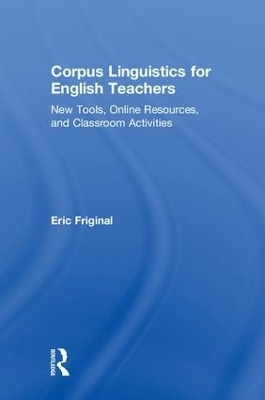
Corpus Linguistics for English Teachers
Routledge (Verlag)
978-1-138-12308-3 (ISBN)
Corpus Linguistics for English Teachers: New Tools, Online Resources, and Classroom Activities describes Corpus Linguistics (CL) and its many relevant, creative, and engaging applications to language teaching and learning for teachers and practitioners in TESOL and ESL/EFL, and graduate students in applied linguistics. English language teachers, both novice and experienced, can benefit from the list of new tools, sample lessons, and resources as well as the introduction of topics and themes that connect CL constructs to established theories in language teaching and second language acquisition. Key topics discussed include:
• CL and the teaching of English vocabulary, grammar, and spoken-written academic discourse;
• new tools, online resources, and classroom activities; and
• focus on the "English teacher as a corpus-based researcher."
With ready-to-use teaching vignettes, tips and step-by-step guides, case studies with practitioner interviews, and discussion of corpora and corpus tools, Corpus Linguistics for English Teachers is a thoughtfully designed and skillfully executed resource, bridging theory with practice for anyone looking to understand and apply corpus-based tools dynamically in the language learning classroom.
Eric Friginal is Associate Professor of Applied Linguistics at the Department of Applied Linguistics and ESL, and Director of International Programs, College of Arts and Sciences, Georgia State University.
Part A
Corpus Linguistics for English Teachers: Overview, Definitions, and Scope
A1. Corpus Linguistic for English Teachers: An IntroductionA1.1. Corpus Linguistic and Pedagogy
A1.2. What is a Corpus?
A1.3. So, what is Corpus Linguistics?
A1.4. Corpora: Types and Descriptions
A1.5. Historical Overview of Corpus Linguistics
A1.6. How to Use this Book
A1.7. CL Limitations and Future Directions
A2. Connections: CL and Instructional Technology, CALL, and Data-Driven LearningA2.1. CL and Instructional Technology
A2.2. CL and Computer-Assisted Language Learning (CALL)
A2.3. CL and Data-Driven Learning (DDL)
A3. Analyzing and Visualizing English Using Corpora
A3.1. Linguistic Analysis of Corpora
A3.2. CL and Visualization of Linguistic Data
Part B
Tools, Corpora, and Online Resources
B1. Corpora and Online DatabasesB1.1. Written Learner Corpora
B1.2. Spoken Learner Corpora
B1.3. Spoken-Written Academic Corpora
B1.4. Varieties of English
B1.5. Online Collections
B2. Collecting Your Own (Teaching) CorpusB2.1. Corpus Collection Process
B2.2. Collecting Written Texts
B2.3. Collecting Spoken Texts
B3. Corpus Tools, Online Resources, and an Annotated Bibliography of Recent Studies
B3.1. Online Directories, Facebook Groups, and MOOCs
B3.2. Corpus Annotation and Mark-Up: Taggers/Parsers
B3.3. Other CL Tools (and where to find them) Online
B3.4. Annotated Bibliography of CL Studies
Part C
Corpus-Based Lessons and Activities in the Classroom
C1. Developing CL-Based Lessons and Activities: An Introduction
C1.1. CL for an EAP Course: A Case Study
C2. CL and Vocabulary InstructionC2.1. Identifying and Analyzing Vocabulary from Authentic Materials in an ESP Class
C2.2. Using a Concordancer for Vocabulary Learning with Pre-Intermediate EFL Students
C2.3. Implementing the Frequency-Based VocabProfile Tool from LexTutor
C3. CL and Grammar InstructionC3.1. Analyzing Verb Usage: A Concodancing Homework
C3.2. Developing Corpus-Based Materials: Past or Past Progressive with Telicity
C3.3. Quantifiers in Spoken and Academic Registers
C3.4. Teaching Linking Adverbials in an English for (Legal) Specific Purposes Course
C3.5. AntConc Lesson on Transitions for an Intermediate Writing Class
C3.6. "The Explorer’s Journal:" A Long-Term, Corpus Exploration Project for ELLs
C4. CL and Teaching Spoken/Written Discourse
C4.1. Using COCA to Answer the Question on Everyone's Lips
C4.2. Using Text Lex Compare to Examine the Language of Political Speeches
C4.3. An Eight-Week Corpus-Based Writing Course for Academic Professionals
C4.4. Incorporating a Corpus-Based Text Visualization Program in the Writing Classroom
| Erscheinungsdatum | 29.07.2018 |
|---|---|
| Zusatzinfo | 37 Tables, black and white |
| Verlagsort | London |
| Sprache | englisch |
| Maße | 152 x 229 mm |
| Gewicht | 635 g |
| Themenwelt | Schulbuch / Wörterbuch ► Wörterbuch / Fremdsprachen |
| Geisteswissenschaften ► Sprach- / Literaturwissenschaft ► Anglistik / Amerikanistik | |
| Geisteswissenschaften ► Sprach- / Literaturwissenschaft ► Literaturwissenschaft | |
| Geisteswissenschaften ► Sprach- / Literaturwissenschaft ► Sprachwissenschaft | |
| ISBN-10 | 1-138-12308-0 / 1138123080 |
| ISBN-13 | 978-1-138-12308-3 / 9781138123083 |
| Zustand | Neuware |
| Haben Sie eine Frage zum Produkt? |
aus dem Bereich


